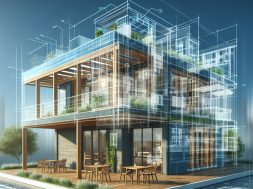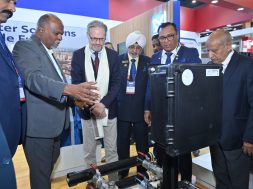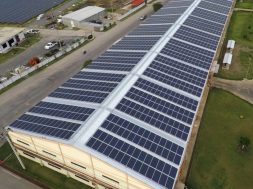Aesthetic MEP design in modern architecture

Experts from the MEP industry shared their views on MEP systems in architectural designs and maintaining the space’s aesthetic appeal.
Early collaboration among architects, MEP engineers, and interior designers is critical for integrating MEP aspects into architectural designs and improving the overall aesthetic. Using BIM for real-time coordination, choosing fixtures that suit the design language, and using recessed or concealed parts all help to retain clean lines. Strategic placement, unique solutions, and matching materials provide consistency, while multi-functional and smart systems offer functionality and visual appeal. Comprehensive planning and extensive implementation ensure that MEP elements are consistent with the design objective, resulting in a coherent and visually appealing environment.
Assimilating MEP systems into architectural designs involves early and continuous collaboration and using advanced tools like 3D BIM (Revit) and Navisworks for clash detection and interoperability, ensuring that changes are automatically reflected across the design. As Bhadresh, GM & Head of MEP of Sattva Developers, highlights, isolating utility areas like chiller plants and electrical rooms outside the building footprint reduces noise and vibration while simplifying maintenance. Façade lighting and solar analysis can enhance aesthetics and energy efficiency. Sheetal Bhilkar, MEP Consultant, Founder & Director of Urja Building Services Consultants Pvt Ltd, emphasises incorporating MEP systems from the conceptual phase to balance aesthetics and functionality, prioritising sustainability and energy efficiency with renewable technologies. Vinay Khatate, Design Lead, MEP Design & Engineering, stresses the importance of early coordination meetings and regular communication, using BIM to ensure systems fit within the architectural vision, optimising space, and maintaining design integrity.
To accommodate MEP infrastructure without compromising interior spaces’ spatial quality or functionality, architects should fuse MEP systems early in the design process, allocating dedicated spaces for utilities while adopting modular and stackable designs to maximise floor space. Concealing MEP elements within architectural features maintains aesthetic appeal, while flexible systems adapt to changing needs without disrupting interior layouts.
Bhadresh suggests “the aesthetic benefits of implementing concepts like UFAD (Underfloor Air Distribution System), which avoids ducting and noise issues that enhance aesthetics by eliminating moving objects in interior spaces and improving indoor air quality. Additionally, merging IoT into interior spaces demonstrates a deliberate approach to technology-enabled workspaces.” At UBSC, Sheetal recommends unique solutions that fit MEP infrastructure while preserving spatial quality and functionality within interior spaces. This is achieved through optimised MEP layouts, space-efficient equipment, and smart zoning strategies, ensuring MEP features blend impeccably into architectural designs. Vinay stresses sustainability and energy efficiency in MEP design by maximising resource efficiency, reducing environmental impact, and promoting occupant comfort. Prioritising passive design strategies like daylighting and natural ventilation minimises reliance on mechanical systems while unifying renewable energy sources further reduces reliance on fossil fuels.
Recognising the need for change, Bhadresh highlights that task and circadian lighting can reduce lighting loads by up to 50 per cent, with task lighting cutting energy use by 60 per cent. Circadian lighting mimics natural sunlight for health benefits, while POE lighting with Dali-based dimming is also efficient. For HVAC, demand control ventilation and free cooling save energy. TFA units improve cooling and air quality, and basement ventilation, pressurised staircases, and atrium exhaust enhance safety during emergencies. In plumbing, flushometer systems provide aesthetics and functionality, and prefabricated POD toilets streamline construction and ensure a superior finish.
Additionally, Sheetal mentions that they take great care in incorporating MEP features like lighting fixtures, HVAC ducts, sprinklers, and plumbing fixtures into our architectural designs. By considering these aspects as vital components of the overall design language, we ensure they add to the space’s aesthetic. They offer design solutions by carefully merging with MEP elements for architectural features, materials, and finishes, enhancing the built environment’s visual impact and functionality.
Furthermore, Vinay says that he cannot accommodate MEP infrastructure without compromising spatial quality or functionality; he employs several strategies: Early collaboration: Engage MEP engineers from the project’s inception to identify optimal locations for MEP elements without impacting spatial design goals. Integrated Design: Use Building Information Modelling (BIM) to visualise and coordinate MEP systems within the architectural design to minimise conflicts. Space planning: Allocate dedicated areas within the building envelope for MEP equipment and service zones, strategically placing them to minimise intrusion into usable spaces. Vertical stacking: Stack MEP infrastructure vertically or strategically locate them within building cores or service shafts to maximise floor area efficiency. Flexible design: Design adaptable spaces with movable partitions or modular elements to accommodate future changes or reconfigurations in MEP systems. Concealed integration: Incorporate MEP elements into architectural features such as ceilings, walls, or floors, maintaining a clean and uncluttered aesthetic while ensuring accessibility for maintenance. Implementing these strategies ensures that MEP infrastructure melds into interior spaces and improves functionality while preserving spatial quality and design intent.
Cookie Consent
We use cookies to personalize your experience. By continuing to visit this website you agree to our Terms & Conditions, Privacy Policy and Cookie Policy.










